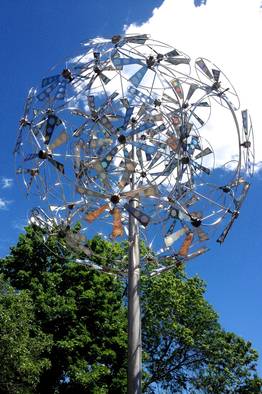More Collectors Donating Works to Hospitals and Nonprofits

Elaine Gans donated ‘Barrett,’ a 1986 piece by Bay Area artist Tom Holland, to Cedars-Sinai Medical Center in Lost Angeles. Photo: Eliane Gans
Los Angeles art adviser and collector Elaine Gans was uncertain, at first, where to donate a large painting by San Francisco Bay Area artist Tom Holland. It was “one of his most important pieces,” Ms. Gans says.
If she gave it to an art museum, the painting risked being put in storage and forgotten, Ms. Gans says. A museum also might not have accepted it, she adds. So, earlier this year, she donated the painting to Cedars-Sinai Medical Center in Los Angeles.
It’s a choice made by a growing number of art collectors who want to donate artwork as part of their estate plan. Instead of going the usual route and donating to an art museum, they are turning to such nonprofits as hospitals, libraries, retirement centers and nursing homes.
More and more hospitals, in fact, have big art collections that are often based largely on donations. Hospital officials say art improves the physical and therapeutic environment for patients, their families and staff. “Studies have shown that artwork helps to reduce stress and boredom, reduces blood pressure and increases white-blood-cell count, all of which are factors in the healing process,” says Jessica R. Finch, art program manager at Boston Children’s Hospital. The hospital has been building a collection—now reaching 5,000 pieces—since 1996, she says.
One of its most significant pieces is a ceiling-hung glass work by Seattle artist Dale Chihuly. “It was from a corporate art collection,” says Ms. Finch. “The corporation couldn’t sell it, because it was so large, and offered it to us.”
Donors of artwork to hospitals often have a personal connection to the institution. Ms. Gans’s three children were born at Cedars-Sinai, and her husband has served on several boards at the facility. Its collection, established in 1976, has more than 4,500 artworks, says the curator, John T. Lange. “I like the hospital’s belief that people there should have something nice to look at, and I wanted to support that,” Ms. Gans says.
Tax considerations
Such gifts typically involve tax considerations for the donors, and certain rules that must be followed to maximize the tax benefits. In order for a donor to receive a deduction for the full-fair-market value of a gift, for example, the recipient organization must show that its use of the artwork is related to its tax-exempt purpose. If there is no related use, the donor’s deduction will be limited to his or her cost basis for the artwork.

‘Dandelion Seed,’ a kinetic sculpture by Bill Wainwright, was donated to the Boston Children’s Hospital by a collector. Photo: Jessica R. Finch
Another consideration should be whether a recipient might quickly resell a donated artwork. According to IRS regulations, if the recipient charity sells the donated item within three years, the donor’s tax deduction is changed from fair market value to the taxpayer’s original buying price, which most often is lower. The purpose of this rule is to insure that the charity actually wants the donation and is not simply enabling a sizable deduction for a taxpayer.
Security concerns
Donors also may want to know that their gifts will be protected and cared for by the recipient. Some institutions have separate fine-art insurance policies that cover damage and theft. Others, such as Hebrew Home at Riverdale, a nursing home in New York’s Bronx borough that was founded in 1917, cover their art and other building contents under a blanket building policy.
Security at a hospital or nursing home tends to be directed at patient safety, not the protection of artwork present. But reports of damage and theft are rare, and other precautions are often taken.
Hebrew Home, for its part, doesn’t install any artworks in its Alzheimer’s wing, as patients “don’t have the same filters as other people and may try to touch or smear it,” says Daniel Reingold, president and chief executive officer of RiverSpring Health, which operates the facility.
Extreme values
For very valuable artworks, an art museum still might be the most appropriate recipient of a donation, and if not a major city museum then perhaps a regional institution or a college museum.
Jennifer Finkel, art curator at the Cleveland Clinic, a nonprofit, academic medical center based in Cleveland, Ohio, oversees a collection of 6,000 objects throughout that organization. Ms. Finkel says that “a Picasso painting wouldn’t be appropriate for us. It might be too fragile or too valuable, and we want to be responsible for the works in our collection.”
On the other hand, when a piece that has been donated to Cleveland Clinic increases dramatically in value, it can be a very welcome event.
Ms. Finkel recalls a Milton Avery painting donated to the hospital back in the 1950s. Some 30 years later, its value had risen to such a degree that when the hospital decided to sell it, she says, the proceeds paid “to furnish an entire new building with art.”
By Daniel Grant
Source: http://www.wsj.com